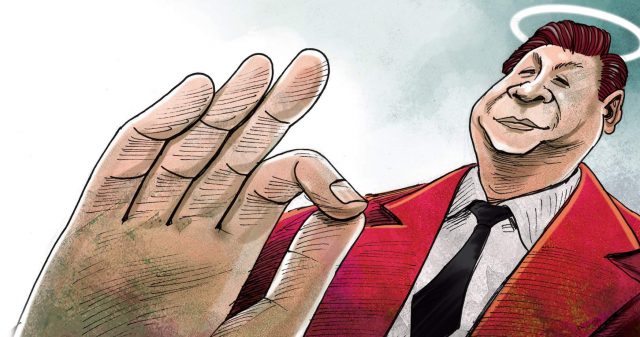
Barring The New Indian Express, I did not see the story on China launching its own Nalanda in any other newspaper. Though, the development appears trivial, it is pregnant with an important message, that China can go to any extent to pip India and ensure its domination in the region.
Meanwhile there was yet another declaration by assistant foreign minister of China Li Huilai. He said in Beijing on Monday last that India’s bid to join the Nuclear Suppliers Group (NSG) had become “more complicated”, effectively ruling out any immediate backing for New Delhi’s application to enter the bloc that controls trade in nuclear technology and know-how. The new description of India’s application by China’s assistant foreign minister came within weeks of New Delhi boycotting the Belt and Road Forum in Beijing.
Li merely echoed what the Chinese foreign ministry spokesperson Hua Chunying said last month, indicating China will not support India’s entry at the NSG’s plenary meeting in June till the bloc evolves a universal formula to accept applications from all countries that haven’t signed the Nuclear Non-Proliferation Treaty (NPT).
Recently, China had taken umbrage over Prime Minister Modi inaugurating the new Bhupen Hazarika Bridge which connects Assam and Arunachal Pradesh. Prior to that China had protested strongly against the Dalai Lama’s visit to Arunachal.
On the surface, all these may appear to be small isolated incidents. But put together, they form a pattern and reveal socialist China’s unabashed imperial mindset. China of course has dropped all its socialist pretensions now. It’s a remorseless capitalist system (reminiscent of Charles Dickens’ novels) run under a ruthless communist dictatorship, sans any human rights or rule of law. No wonder, China tops the world in the number of executions.
Fired by its expansionist ambitions, China has been trying to increase its footprint in the neighbourhood. Apart from Japan (its traditional rival), India is the only other nation in this part of the globe which refuses to fall in line with its hegemonic plans, is difficult to buy over with freebies, stands up against threats or a show of force, notwithstanding her humiliating defeat in 1962.
No doubt China is far ahead of India in terms of physical infrastructure, weapons, number of troops and the size of the economy. Its economy ($11 trillion) is roughly five times that of India. While it exports manufactured goods, its imports from India mostly consist of basic materials such as ores and raw hides. China has an annual trade surplus of over $55 billion with India.
However, India, with its vibrant democracy, a healthy record of human rights, stable institutions and fast-growing economy acts as a counter magnet to China for the neighbourhood and rest of the world.
To cap it all, India scores over China in terms of soft power—it is the birthplace of Buddhism which has enormous influence in South, Southeast and East Asia and in the rest of the world as well.
The decision by China to launch its own Nalanda is to be seen in this context. Close to Patna in Bihar lie the ruins of original Nalanda which was an 800-year-old global university, with 2,000 strong faculty and 20,000 residential scholars on its rolls, when an Islamic fanatic Bakhtiyar Khilji burnt it down circa 1200 AD. A decade ago, the Indian government decided to rekindle the spirit of Nalanda. While millions have been spent, the project has failed to take off. Over 400 acres of land acquired for the dream project has nothing tangible to show till date.
In contrast, the Chinese have quickly gone ahead with their project of creating a duplicate Nalanda. Keeping in mind the strategic socio-political goals, the new university will have close association with the Buddhist centres in Thailand, Sri Lanka, Nepal and Cambodia.
Spread over an area of more than 600 acres, the sea-facing structure is situated on the scenic Nanshan Mountains. Borrowing a concept from Yoga Vashistha and Mahayana Buddhism, the Chinese have rechristened the university coastline “Brahma Pure Land”. While a detailed syllabus is to be worked out, the university will offer courses in Pali, Tibetan and Chinese.
Over the years, China has shown special interest in Lumbini, the birthplace of Buddha. It’s in Nepal, just across the border with India. China has been aggressively promoting Lumbini to counter Saranath and Bodh Gaya in India, the two sites associated with the enlightenment of Buddha. The entire exercise is aimed at bringing down India’s predominant position in the Buddhist world.
In fact China has been trying hard to establish itself as a claimant to Buddhist heritage— an intrinsic part of India’s myriad spiritual traditions. Even relics connected with the Buddha are now being “discovered” in China. Few years ago, Chinese archaeologists claimed to have found a skull bone of Buddha inside a model of a stupa.
China, a communist anti-God state, is resorting to Gestapo-type operations to squash all traces of original Buddhism in Tibet, killing and arresting monks and demolishing ancient monasteries. Simultaneously, it is also striving hard to emerge as a great promoter of Buddhist traditions.
The reasons for this contradiction are not very difficult to seek. The Chinese will do anything to achieve their national goals— even steal Indian Buddhist heritage, stamp it as “made in China” and market it as their own.
The Chinese are ingenious in manufacturing duplicates of global brands which look and feel as good as the originals. But their products enjoy a poor reputation for their quality and don’t last long. Will the fates of the made-to-order Chinese brand of Buddhism and the duplicate Nalanda be different?
By Balbir Punj
Former Rajya Sabha member and Delhi-based commentator on social and political issues
Courtesy: New Indian Express














